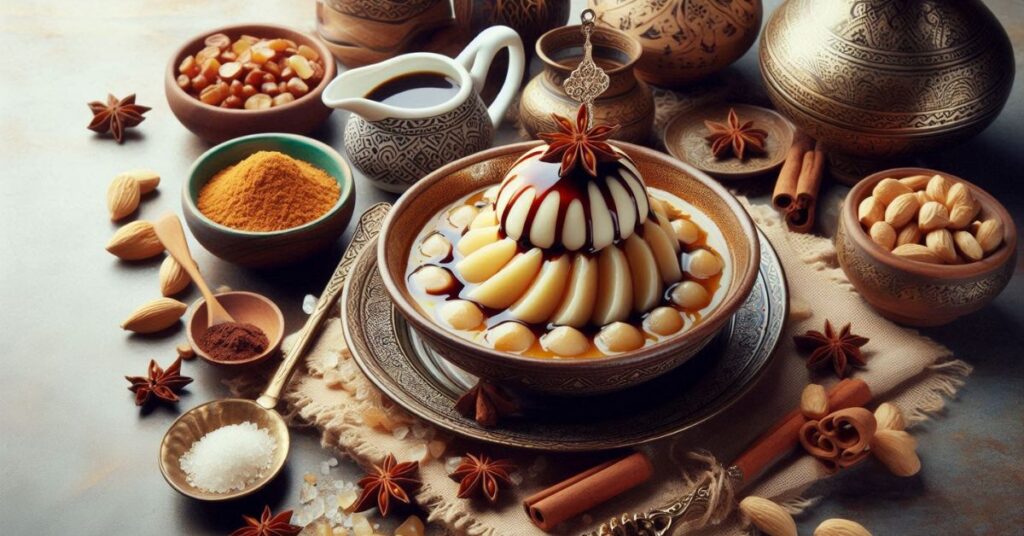Cultural Significance in Mouhalabieh, a delicate and creamy milk pudding, is more than just a dessert in Middle Eastern cuisine. Its smooth texture, mild tastes, and long past make it culturally and historically important. This humble dish, made from milk, sugar, and strengthening agents like cornstarch or rice flour, has been a staple in homes and parties for ages. It started during the Umayyad time but has become a popular dish in many Middle Eastern, North African, and Mediterranean countries. Mouhalabieh is important not just as a food but also in hospitality, religious customs, and social events.
A Historical Journey: From Royal Tables to Modern Kitchens
Cultural Significance in Mouhalabieh has a past that goes back to the early days of Islam, during the Umayyad rule in the 7th to 8th century. It is believed to have been brought in by General Al-Muhallab ibn Abi Sufra. As time went on, the dish became popular in Persia, the Levant, and the Ottoman Empire, changing to fit local flavors and ingredients. Even with these differences, it was still a comfortable custard made with milk that everyone liked.
Dessert has always been an important part of Middle Eastern food, lasting through many changes in culture and politics over the years. It is still often made at home and served in Middle Eastern and Mediterranean places around the world, keeping its history alive.
Symbol of Hospitality and Celebration
Mouhalabieh is not just a dessert; it represents kindness in many countries. Offering this dessert to friends shows kindness and hospitality. In Middle Eastern society, giving sweets is a way to show respect and gratitude. Mouhalabieh is a popular choice because it is simple and loved by many.
In many families, making Mouhalabieh is a custom passed down from one generation to the next. Grandmothers show younger family members how to get the right texture, and each family might have its own special touch. Some families might add cardamom, while others like a bit of orange blossom or rose water. Making and sharing this dish brings families together and helps keep ethnic traditions alive.
A Staple in Religious and Festive Occasions
Mouhalabieh is important in religious and social events. During Ramadan, this food is often served at iftar, the meal that breaks the daily fast. Its light and filling qualities make it perfect for after a long day of fasting, as it is soothing and easy to stomach.
Mouhalabieh is also eaten during Eid, parties, and special events. Having it on the dinner table represents joy, plenty, and togetherness. Many countries make it for parties when a baby is born, as a way to welcome the new family member with a sweet treat.
Regional Variations and Culinary Adaptations
Despite its common base ingredients, Mouhalabieh has many regional adaptations that reflect the diversity of Middle Eastern and Mediterranean cultures.
- Lebanese & Syrian Style: Often flavored with rose or orange blossom water and garnished with crushed pistachios.
- Turkish Muhallebi: A variation that sometimes incorporates mastic resin for a distinct chewy texture.
- Persian Influence: Saffron and cardamom are frequently added, lending the dessert an aromatic and golden hue.
- Egyptian Mihallabiya: Can be layered with nuts, dried fruits, or even coconut for added texture and flavor.
These variations highlight how different cultures have embraced and personalized this simple yet elegant dish over time.
A Symbol of Simplicity and Nourishment
Mouhalabieh is not only loved for its taste but also for its health benefits. It is a light and healthy treat usually made with milk and natural flavorings. This dish is loved by children and older adults because it is soft and easy to swallow.
Some versions use almond milk or rice flour, making them great for people with food restrictions. In the past, it was thought to help with digestion, which added to its popularity as a tasty and healthy meal.
Modern-Day Appreciation and Global Recognition
Mouhalabieh, a Middle Eastern dish, has become famous worldwide due to globalization. Famous chefs and home cooks try out new ingredients like chocolate, coffee, or unusual foods while keeping the dish’s regional flavors.
Health-conscious food lovers are also enjoying this treat because it has less fat and sugar than many Western-style puddings. Vegan and dairy-free options are now available, allowing more people to enjoy it while keeping the classic taste.
Conclusion: More Than Just a Dessert
Mouhalabieh is not just a dish; it’s an important part of Middle Eastern culture. Its use in houses and at special events shows its cultural importance, representing welcome, joy, and shared memories. Mouhalabieh is a loved dish that people enjoy during Ramadan, family gatherings, or just as a warming treat. It remains an important part of the culture.
Mouhalabieh is a symbol of the rich past and common customs in Middle Eastern culture as the world celebrates different food traditions. Its simple, elegant, and classic qualities make sure it will be a loved dish for many years.

